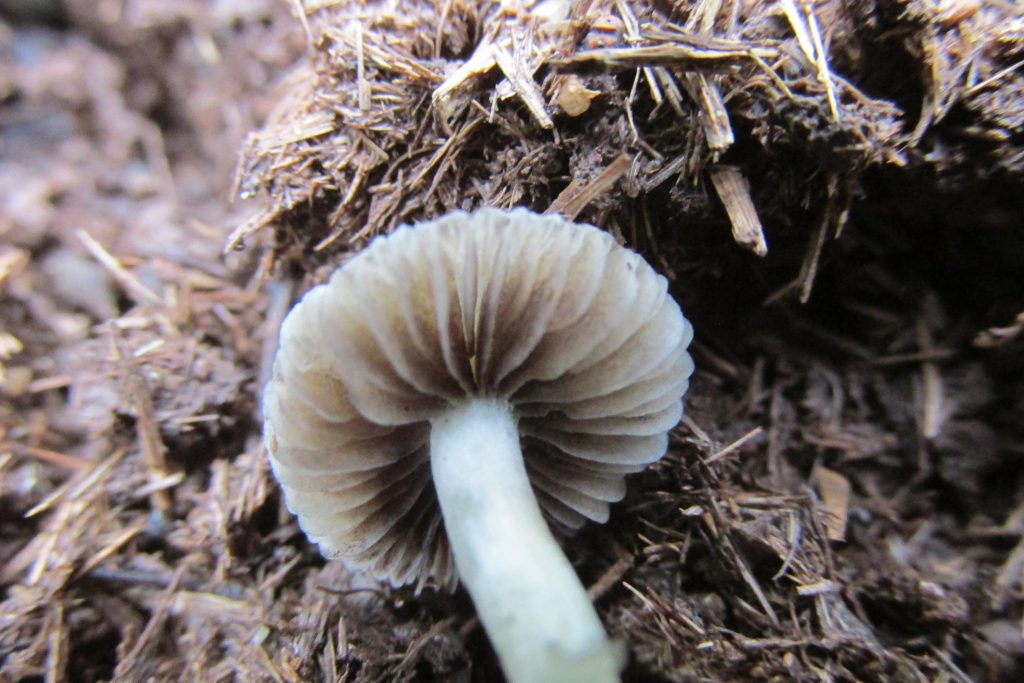Psilocybe natalensis[i] is a close relative of the famous Psilocybe cubensis and is similar to it in many respects—to the point that the main way to tell the difference is through DNA analysis. Like P. cubensis, P. natalensis is strongly psychoactive. It is native to the Natal region of South Africa, and although it’s not clear whether the species has been used in historical times, there is some evidence of ancient, prehistorical use.
P. natalensis is not well known among psychonauts—the species was only described scientifically a few decades ago—but those who have tried it like it, describing it as just like P. cubensis but better.
Identification and Description
Cap: Small to medium-sized, cone-shaped or bell-shaped when young, becoming almost flat with age but retaining a slight, central bump. Sticky on top, sometimes with pieces of the universal veil attached. Brown when when young, then fading, especially at the edges. Bruises blue.
Stem: Tallish, relative to the cap’s size, white when young becoming yellowish with age. Mature specimens have a stem ring, the remnants of the partial veil, that appears almost black because spores collect on it. Bruises blue.
Gills: Covered by a veil initially, then gray with white edges, becoming purple-black as the spores mature.
Spores: Sub-ellipsoid.
Spore Print: Purple-black.
Edibility: Psychoactive.
Habitat: Arid grasslands.
Range: South Africa.
P. Natalensis can’t be reliably differentiated from P. cubensis on its appearance alone[ii].
Look-alikes
P. natalensis looks almost exactly like P. cubensis. Both also bear a more than passing resemblance to a great many other small, gray-brown, non-descript mushrooms. These so-called LBMs (“little brown mushrooms”) are far from identical to each other, but they do share the same general “look” and are easy to mix up if any of the steps of proper mushroom identification are skipped. Many LBMs are psychoactive, but some are simply culinary, and some are dangerously toxic. This is not a group for beginners at foraging—even beginners who are thoroughly familiar with Psilocybes from using or cultivating them.
Effects
The effects of taking P. natalensis are essentially the same as for P. cubensis, since both contain psilocybin, psilocin, and baeocystin. In fact, the amounts and proportions of these constituents are quite similar in both. And yet. P. natalensis is reputed to offer a high that is clearer, smoother, and “friendlier” in feel, without as much body load. While we question reports of qualitative differences between P. cubensis strains—there are just so many other factors that can alter the course of a trip that any biochemical differences between strains are probably swamped—P. Natalensis is a different species. Maybe its high really is consistently more enjoyable.
Potency and Dosage
P. natalensis is biochemically similar to P. cubensis, including having a similar concentration of psychoactive substances, so they ought to be similar in potency—but users often report that P. natalensis is much stronger. Psychoactive mushroom species often vary in potency, and it’s hard to say what average potency really is without measuring a large number of samples, so it’s hard to be sure exactly what the situation is, but it’s quite likely P. natalensis is more potent than the average cube.
That means it’s important to start with a much smaller dose than you otherwise might. It’s always better to err an on the side of taking too little than too much because the risk of side effects increases the more you take. Anyway, you can always eat a little more if you want a stronger experience, but once you’ve swallowed the mushroom, you’re on board for the duration of the ride.
Growing
P. natalensis hasn’t been cultivated widely yet, but it’s likely to respond to the same methods used for P. cubensis—although so far it appears more resistant to mold, which could be a big advantage.
Toxicity, Safety & Side Effects
Because P. natalensis is not widely used—and of course cannot be properly studied because its use is widely illegal—it’s hard to be sure what the risks of using it might be. Probably they are similar to the risks of using P. cubensis, which would make this mushroom relatively safe as mind-altering methods go, but not risk-free. Psilocybin can have unpleasant side effects, including nausea, poor balance, and intense anxiety. More serious effects, such as convulsions, are rare but possible. P. natalensis contains psilocybin, so it must have all those side effects. But the possibility that it may have a few additional side effects—as indeed some Psilocybe species do (notably “wood-lover’s paralysis”)– can’t be ruled out.
It’s important to follow basic safety precautions for the use of psilocybin in any form, including allowing adequate time afterwards for processing and integrating the experience—otherwise you risk not learning from your trip, and that would be too bad.
References:
[i] Gandy, S., Atalay, A. (2023). Psilocybe natalensis Mushrooms: Growing, Potency, and Benefits. Third Wave



